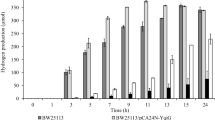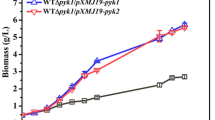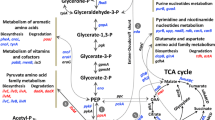Abstract
To obtain strain YP211 with a high tendency for accumulating pyruvate, central metabolic pathways were modified in Escherichia coli MG1655. Specifically, seven genes (ldhA, pflB, pta-ackA, poxB, ppc, frdBC) were knocked out sequentially and full pyruvate dehydrogenase was retained. In batch fermentation with M9 medium, pyruvate yield and production rate reached 0.63 g/g glucose and 1.89 g/(1 h), respectively. Meanwhile, the production of acetate, succinate, and other carboxylates was effectively controlled. To understand the physiological observations, we further completed genome-wide transcription analysis of wild-type and YP211. As the acetic acid pathways were blocked, the pathways of convertion of pyruvate to phosphoenol pyruvate and acetyl CoA were enhanced. The transcription of pck, as an alternative gene for ppc, was increased by 2.6 times. So even if gene ppc was inactivated, the tricarboxylic acid pathway was still enhanced in YP211. In order to balance intracellular NADH/NAD+, oxidative phosphorylation and flagellar assembly system were also up-regulated significantly.
Graphical Abstract
Biochemical pathways involved in pyruvate accumulation in YP211 (a). Transcriptional differences of genes related to pyruvate metabolism between strain YP211 and E. coli wild-type (b).




Similar content being viewed by others
References
Causey T, Shanmugam K, Yomano L, Ingram L (2004) Engineering Escherichia coli for efficient conversion of glucose to pyruvate. Proc Natl Acad Sci USA 101:2235–2240
Chang Y, Wang A, Jr J (1994) Expression of Escherichia coli pyruvate oxidase (PoxB) depends on the sigma factor encoded by therpoS (katF) gene. Mol Microbiol 11:1019–1028
Chang D, Shin S, Rhee J, Pan J (1999) Acetate metabolism in a pta mutant of Escherichia coli W3110: importance of maintaining acetyl coenzyme A flux for growth and survival. J Bacteriol 181:6656–6663
Koebmann B, Westerhoff H, Snoep J, Dan N, Jensen P (2002) The glycolytic flux in Escherichia coli is controlled by the demand for ATP. J Bacteriol 184:3909–3916
Lee PC, Schmidt-Dannert C (2002) Metabolic engineering towards biotechnological production of carotenoids in microorganisms. Appl Microbiol Biotechnol 60:1–11
Li Y, Chen J, Lun S (2001) Biotechnological production of pyruvic acid. Appl Microbiol Biotechnol 57:451–459
Li Y, Hugenholtz J, Chen J, Lun S (2002) Enhancement of pyruvate production by Torulopsis glabrata using a two-stage oxygen supply control strategy. Appl Microbiol Biotechnol 60:101–106
Liu L, Xu Q, Li Y, Shi Z, Zhu Y, Du G, Chen J (2007) Enhancement of pyruvate production by osmotic-tolerant mutant of Torulopsis glabrata. Biotechnol Bioeng 97:825–832
Liu S, Zhang L, Mao J, Ding Z, Shi G (2015) Metabolic engineering of Escherichia coli for the production of phenylpyruvate derivatives. Metab Eng 32:55–65
Liu Y, Yang M, Chen J, Yan D, Cheng W, Wang Y, Thygesen A, Chen R, **ng J, Wang Q, Ma Y (2016) PCR-based seamless genome editing with high efficiency and fidelity in Escherichia coli. PLoS ONE doi: 10.1371/journal.pone.0149762
Shi A, Zhu X, Lu J, Zhang X, Ma Y (2013) Activating transhydrogenase and NAD kinase in combination for improving isobutanol production. Metab Eng 16:1–10
Tomar A, Eiteman M, Altman E (2003) The effect of acetate pathway mutations on the production of pyruvate in Escherichia coli. Appl Microbiol Biotechnol 62:76–82
Vemuri G, Altman E, Sangurdekar D, Khodursky A, Eiteman M (2006) Overflow metabolism in Escherichia coli during steady-state growth: transcriptional regulation and effect of the redox ratio. Appl Environ Microb 72:3653–3661
Wada M, Narita K, Yokota A (2007) Alanine production in an H+-ATPase and lactate dehydrogenase-defective mutant of Escherichia coli expressing alanine dehydrogenase. Appl Microbiol Biotechnol 76:819–825
Wang Z, Gao C, Wang Q, Liang Q, Qi Q (2012) Production of pyruvate in Saccharomyces cerevisiae through adaptive evolution and rational cofactor metabolic engineering. Biochem Eng J 67:126–131
Wendisch V, Bott M, Eikmanns B (2001) Metabolic engineering of Escherichia coli and Corynebacterium glutamicum for biotechnological production of organic acids and amino acids. Curr Opin Microbiol 9:268–274
Xu P, Qiu J, Gao C, Ma C (2008) Biotechnological routes to pyruvate production. J Biosci Bioeng 105:169–175
Yang S, Chen X, Xu N, Liu L, Chen J (2014) Urea enhances cell growth and pyruvate production in Torulopsis glabrata. Biotechnol Prog 30:19–27
Yokota A, Shimizu H, Terasawa Y, Takaoka N, Tomita F (1994) Pyruvic acid production by a lipoic acid auxotroph of Escherichia coliW1485. Appl Microbiol Biotechnol 41:638–643
Yokota A, Henmi M, Takaoka N, Hayashi C, Takezawa Y, Fukumori Y, Tomita F (1997) Enhancement of glucose metabolism in a pyruvic Acid-hyperproducing Escherichia coli mutant defective in F1-ATPase Activity. J Ferment Bioeng 83:132–138
Zhou J, Huang L, Liu L, Chen J (2009) Enhancement of pyruvate productivity by inducible expression of a F0F1-ATPase inhibitor INH1 in Torulopsis glabrata CCTCC M202019. J Biotechnol 144:120–126
Zhu Y, Eiteman M, Altman R, Altman E (2008) High glycolytic flux improves pyruvate production by a metabolically engineered Escherichia coli strain. Appl Environ Microb 74:6649–6655
Acknowledgements
The work was supported by the National High Technology Research and Development Program of China, No. 2014AA021900, and the Foundation (No. 2015IM002) of Key Laboratory of Industrial Fermentation Microbiology of Ministry of Education and Tian** Key Lab of Industrial Microbiology (Tian** University of Science & Technology).
Author information
Authors and Affiliations
Corresponding author
Electronic supplementary material
Below is the link to the electronic supplementary material.
Rights and permissions
About this article
Cite this article
Yang, M., Zhang, X. Construction of pyruvate producing strain with intact pyruvate dehydrogenase and genome-wide transcription analysis. World J Microbiol Biotechnol 33, 59 (2017). https://doi.org/10.1007/s11274-016-2202-5
Received:
Accepted:
Published:
DOI: https://doi.org/10.1007/s11274-016-2202-5




